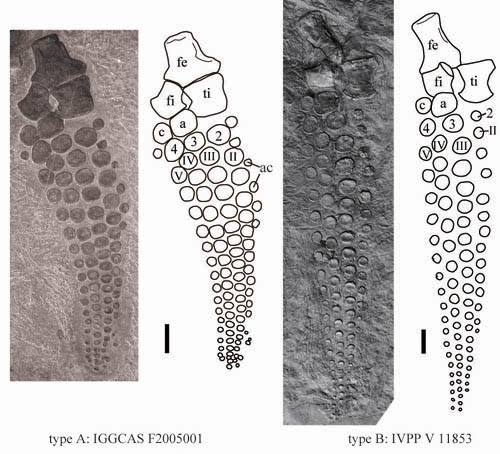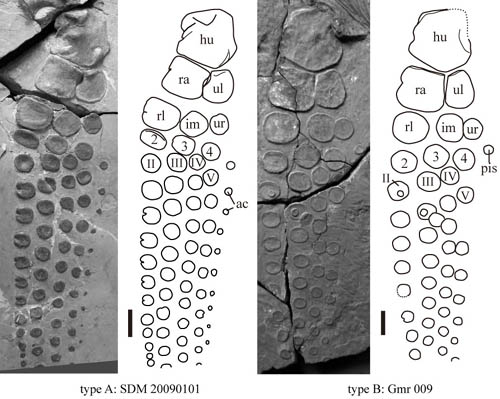Exploring Sexual Dimorphism in Large-sized Long-snout Ichthyosaurs
A large number of large-sized long-snout ichthyosaur skeletons have been excavated from Guanling, Guizhou and adjacent areas since 2000. Totally 14 specimens had been described and reported often as different genera and species. Recently, based on the similarity of the cranial morphology, all of these specimens were assigned to one species, Shastasaurus tangae. The evidence of live birth is abundantly known among ichthyopterygians. Unfortunately, males and females cannot be identified directly because the gravid specimen is still lack in Shastasaurus tangae.
Drs. SHANG Qing-Hua and LI Chun, Institute of Vertebrate Paleontology and Paleoanthropology (IVPP), Chinese Academy of Sciences, closely observed and compared these 14 specimens and two newly uncovered large-sized long-snout ichthyosaur specimens, and grouped them into two morphotypes (type A and type B) based on the data of the skull and limb. In an article published in the latest issue of Vertebrata PalAsiatica 51 (4), researchers propsed that the dichotomy should most probably reflected sexual variation because the number of these two morphotypes is subequal, their size ranges are similar, and all the specimens come from the same locality and same horizon.
In most described large-sized long-snout ichthyosaur specimens, the hindfin is relatively thin and long, and with no preaxial accessory digit developed. At meantime the metatarsal and proximal one or two phalanges of digit II in these specimens are small in size or absent, which is named as type A. In contrast, the hindfin of new specimens is relatively wider and with well-developed preaxial accessory digit. On the other hand, the metatarsal and proximal phalanges of digit II are similar in size as in digits III and IV, which is named as type B. Furthermore, the postaxial accessory digit, as a typical feature of the forefin of type B, does not present at type A. As indicated by the hindfin and forefin, the Guanling large-sized long-snout ichthyosaur skeletons can be assigned to two groups.
Among the above mentioned 16 large-sized long-snout ichthyosaur specimens, eight of them are represented by both the skull and postcranial skeleton. According to the features of hindfin and (or) forefin, three of them can be referred to type A, four of them can be assigned to type B, and one is not referable because of the poor preservation of the specimen.
Coincident with the data of the leg, the proportions between skull elements also reveal two subgroups with a slight difference of details. The skull of type A is relatively stout, with an angle of the bifurcated parietal sagittal crests more than 50o. In contrast, the skull of type B is relatively slender, with an angle of the sagittal crest around 30o. Within eight specimens, the ratio of skull/snout length reaches about 1.58 in type A while 1.49 in type B. The length of upper temporal fenestra is less than twice its width in most of type A but more than twice in type B.
The skull length is within a range of 76.5 to 92 cm in type A and a range of 61 to 96 cm in type B. The body size differences match those of the skull in most specimens, especially those with the poorly ossified metatarsal of digit II. The differences between the two types cannot be considered as the attribution of ontogenetic variation.
Sexual dimorphism had been mentioned in a Jurassic ichthyosaur Eurhinosaurus huenei. The apparent dichotomy exhibited at the prenarial ratio (ratio of prenarial segment to mandibular length), sclerotic ratio (ratio of internal diameter of scerotic ring to mandibular length), total digital count and the number of primary digits. One subgroup species show the relatively long snout, large internal diameter of scerotic ring and more digital count. Another subgroup species show the opposite features. These sexual dimorphism features are very similar to those of Shastasaurus tangae.
The ratio of the trunk to tail length indicates that type A skeleton usually has a relatively long trunk and a short tail compared with type B. The most consistently dimorphic trait in living lizards is that the females have larger interlimb in length than the males, with which females could provide a space for more eggs (fecundity selection). According to the evidence of the pregnant Keichousaurus fossil and some pachypleurosaur fossils, the male usually has a longer tail than female. Type A most probably represents the female and type B the male.
"It might be possible that the two morphotypes represent different species if those variations would be considered as interspecific differences. However, we are inclined to believe that they are most probably resulted from sexual dimorphism on the basis of the similarity of the skull anatomy, although more specimens are needed to verify this", said lead author Dr. SHANG Qing-Hua of the IVPP.

Fig.1 Two types of hindfin of Shastasaurus tangae, scale bar = 5 cm. (Image by SHANG Qing-Hua)

Fig.2 Two types of forefin of Shastasaurus tangae, scale bar = 5 cm. (Image by SHANG Qing-Hua)

